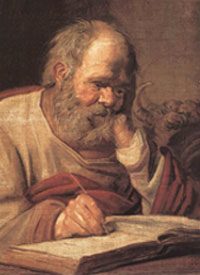
“And it came to pass in those days that a decree went forth from Caesar Augustus that all the world should be taxed.” (Luke 2:1) Some (more recent) translations of the Gospel of Luke have “enrolled” instead of “taxed,” but the enrollment was for the purpose of taxation. Rome’s IRS was not omnipresent like our own and required citizens to be enumerated by town and city in order to assess the revenue expected of each locality.
Those who are not “into” Bible reading may be unclear as to what stories and what characters are in which Gospel. Matthew, Mark, and Luke, known as the synoptic (with one eye) Gospels, have much overlap, while the fourth Gospel, the Gospel of Saint John, is much different and has only a few, albeit important, points of similarity. Matthew, the most Jewish of all the Gospels, is designed to show the divine kingship of Jesus, but also the fulfillment of Hebrew prophecies of the coming Messiah. The Gospel of Saint Mark was written to show the power of the Son of God, something a Roman audience could understand and appreciate. John’s Gospel, the last to be written, shows Jesus as the Eternal Word, the divine Logos that preexisted even the Creation.
“In the beginning was the Word and the Word was with God. And the Word was God. The same was in the beginning with God. All things were made by him and without him was not made anything that was made. In him was life and the life was the light of the World. And the light shineth in the darkness and the darkness comprehended it not.” (John 1:1-5)
It is clearly the most exalted of all the Gospels and the most theologically developed. John did not repeat many of the stories of the other three evangelists because they were already well known. But reading John, we nonetheless feel something is missing from his narrative, something that would show us the human face of Jesus. In John’s Gospel, as in Mark’s, Jesus drops from Eternity onto earth full-grown and ready to begin his ministry. Matthew and Luke give us their respective narratives of the conception and birth of the Savior, Matthew from the perspective of Joseph, the foster father of Jesus, and Luke from the vantage point of Mary, who receives the Good News directly from the angel Gabriel. It is Luke’s narrative that is arguably most beloved, the one that has inspired so much Christmas music and poetry about the light that shone “round yon Virgin Mother and Child” in the “Little Town of Bethlehem.” Indeed, Luke, even more than the other evangelists, shows us in very human terms how “the hopes and fears of all the years” were met in the carpenter’s son from Nazareth, “born of a woman” in “the fullness of time” in the city of David, the King.
There is so much that appears only in Luke’s Gospel that simply to identify every story, every homily, every parable that is unique to the third Gospel would fill this entire article and then some. But it is worth naming a few. Only in Luke’s Gospel do we learn of Mary’s cousin Elizabeth and her husband Zachariah and the miraculous gift of a son to a couple that was childless and advanced in years. Only from Luke do we learn that when Elizabeth was “in her sixth month, the angel Gabriel went to a town in Galilee called Nazareth to a virgin betrothed to a man named Joseph of the house of David. And the virgin’s name was Mary.” (Luke 1:26-27) Only from Luke do we learn of Mary’s hasty trip to visit her cousin to share the Good News and how the babe in Elizabeth’s womb leapt at the sound of Mary’s greeting. Only Luke records Mary’s Magnificat (Luke 1:46-55), the beautiful hymn by which, as Martin Luther would say centuries later, “Mary shows us how to love and praise God.” Only in Luke do we find the story of the birth in the cave, the laying of the newborn in a manger because “there was no room at the inn.” Only Luke tells us that the Good News was next delivered to those least in the kingdom of man, the shepherds in the field keeping watch o’er their flocks by night. To the shepherds the angel proclaims “the Good News of a great joy for all people: for unto you is born this day in the city of David, a savior who is Christ the Lord.” (Luke 2:10-11) And it is Luke who tells us three times that the babe is lying in a manger, a feeding trough, where the shepherds would find him.
No Deterring the Determined
Let us pause for a moment and reflect on the shepherds, who may have gone AWOL or who may have, as reflected in Christian art, brought their sheep with them to the stable. Luke does not tell us, but he does tell us they hurried off to Bethlehem to see the remarkable thing the angel of the Lord had revealed to them. The angel expected no less, for the shepherds heard, “You will find a babe wrapped in swaddling clothes lying in a manger.” That would be a sign for them, they were told. Of what is it a sign for us?
Various denominations of Christians claim Christ as their own and their numbers vary from the great to the small. Surely, the truth on such a great matter is not to be determined by a head count. But perhaps the largest congregation is the faithless Order of the Indifferentists, who say they believe the Good News but refuse to stir themselves on a Sunday morning for worship or on a weekday night for Bible study. The angel told the shepherds where the newborn Savior could be found. It apparently did not occur to them to say, “That’s nice, thank you very much” and then go back to sleep. They went to Bethlehem. For some of us, Bethlehem is literally at the next corner, less than a block away. And yet we do not go.
But they went. Luke must have had a reason for relating the pilgrimage of the shepherds. King Herod, we learn from Matthew, sought Jesus to kill him, along with an undetermined number of other children who became what we call “collateral damage.” The shepherds, disdained by the learned and pious men of their day, sought Christ with open minds and hearts and found him in a manger. And we have the devout Indifferentists who won’t come to Christ unless there is something in it for us. Give us a 9/11 and we’ll flock to the churches to pray for safety and security — for a little while. Give us a recession and we’ll pray for full employment — or at least our own employment or job security. But give us peace and prosperity and we’ll forget about God and be fat and happy in our own little illusions of self-sufficiency. Trouble us not, we gave our all at the office.
History by and of Luke
So who was this evangelist who so movingly portrayed a world and worlds set in motion by the birth of a child in a stable? Luke is an historian about whom there is little history. But one fact about his life stands out right away among the New Testament’s human authors. Though the four Gospels and the Book of Acts are littered with conflicts between the emerging Church and the defenders of the Temple and its authority, all but one of the New Testament authors were Jews. The exception is Luke, the author of the Gospel that bears his name and the Book of Acts. Taken together the two books make up the largest block of writing by any author in the New Testament, exceeding even the writings of the Apostle Paul with all of his epistles (not counting Hebrews).
That Luke was a foreigner may explain why his Gospel spends considerably less time and ink than Matthew’s does on how the acts performed by and on Jesus of Nazareth are fulfillments of prophecies by the Hebrew prophets. Luke was writing for a Gentile audience, and his Gospel reflects the compassion Jesus had for foreigners. Thus the parable of the Good Samaritan is found only in Luke’s Gospel. So is the story of the 10 lepers cured by Jesus, only one of whom returned to offer thanks — and that one was a Samaritan. (Luke 17:11-19)
Other models of faith in Luke’s Gospel include Naaman the Syrian, the widow of Naim, and the Roman centurion, whose story of faith is also in Matthew’s Gospel. Yet in Matthew’s Gospel we find the narrative of the birth of the One who will be called Jesus, “for he will save his people from their sins.” For Matthew, “his people” no doubt meant the Jews. Yet Luke tells us of the prophecy of Simeon, who declares the babe brought to the temple by Mary and Joseph will be “a light unto the Gentiles and the glory of thy people, Israel.” (Luke 2:32)
Some of the Lucan themes are carried over into John’s Gospel. It is John who tells us, for example, of the conversation Jesus had with the Samaritan woman at the well. (John 4: 1-30) Luke had already established more than the other New Testament writers that Jesus went far beyond Jewish law and custom in his dealings with women. Today’s feminists, many of whom find Saint Paul’s male chauvinism revolting, should rejoice at the view of women in the New Testament narratives related by Paul’s traveling companion, the Gentile Luke. Some believe the story of the woman taken in adultery, found in the eighth chapter of John’s Gospel, was originally in Luke. It definitely reflects Luke’s theme of a compassionate Savior, as well as opposition to the obvious double standard of the times — some would say of all time — in that the woman, captured “in the very act” was taken alone, her partner in the crime apparently let go. The penalty was death by stoning. The Lord’s response: “Let he who is without sin cast the first stone.” And, let us not forget, his word to the woman was, “Go, and sin no more.” (John 8:1-11)
In the seventh chapter of Luke, we find Jesus at table at the home of Simon the Pharisee. A woman who has obviously crashed the party dares to approach the prophet from Nazareth and kneels at his feet, caressing his feet and washing them with her tears. Observing the shock on the faces of his scandalized host and distinguished guests, Jesus knows that the woman is regarded as a sinner. “She is forgiven much because she has loved much,” Jesus informs them. And to the woman, he says, “Thy sins are forgiven.” And, “Thy faith hath saved thee. Go in peace.” (Luke 7:36-50)
According to the early Church historian Eusebius, Luke was born at Antioch in Syria. The subject of Taylor Caldwell’s bestselling novel, Dear and Glorious Physician, Luke was, according to both Scripture and tradition, a doctor. Indeed, the Apostle Paul referred to him as such, as did Saints Irenaeus and Jerome. That does not mean, however, that he was either highborn or rich. Indeed, some scholars believe he was born a slave. It was a fairly common practice for those who had slaves to educate one or more of them in medicine so they would have a family physician.
Nothing is known of Luke’s conversion, but from the Book of Acts, we get some idea of where he joined Saint Paul on the missionary journeys. Luke writes as an historian in the third person, recounting the events in the lives of others, until the 16th chapter. In Acts 16:10 “they” becomes “we”: “When he (Paul) had seen the vision, we immediately tried to cross over to Macedonia, being convinced that God had called us to proclaim the good news to them.”
Luke first joined Paul’s company then, at Troas at about the year 51, and accompanied him into Macedonia and eventually to Philippi. At that point, the narrative reverts to the third person, suggesting Luke was not imprisoned with Paul there. And when Paul left, Luke remained with the Church In Philippi. Seven years later, when Paul returned to the area on his third missionary journey, the narrative switches to “we” again. Luke apparently traveled with the company through Miletus, Tyre, and Caesarea, to Jerusalem.
Luke remained with Paul during the Apostle’s imprisonment in Rome in about the year 61. “Epaphras, my fellow prisoner in Christ Jesus, sends greetings to you, and so do Mark, Aristarchus, Demas, and Luke, my fellow workers,” Paul wrote in Philemon 23 and 24. And it was Luke who remained with Paul to the end, after others had left him. “Only Luke is with me.” (2 Timothy 4:11)
While Luke’s fellowship and travels with Paul provide the basis for the account of the Apostle’s dramatic conversion (Acts 9:3-9 and Acts 22:6-22) and of the missionary journeys in the early days of the Church, it is his fellowship also with many of the women of the story, and especially with Mary, the mother of Jesus, that enabled Luke to give such a dramatically unique account of the infancy, childhood, and ministry of Jesus. It could only have been from Mary that the evangelist learned of the story of Zachariah and Elizabeth and the miraculous conception of John the Baptist; of the angel’s visit to Mary, of the journey to Bethlehem, the birth in the stable, the child’s bed in a manger, and the visit by the shepherds and their account of the angel that appeared in the night, as “the glory of the Lord shone ’round about them.” It is almost certainly from Mary that Luke learned of the only incident recounted in the Bible of the life of Jesus between infancy and his ministry in Galilee — the story of the child Jesus at age 12 remaining behind in Jerusalem after the Passover and being found three days later in the Temple, listening to the rabbis and asking them questions. It may have been from Mary also that John, who took the Lord’s mother into his own home after the Savior’s death on the cross, learned what she no doubt learned from her divine Son: “In the beginning was the Word and the Word was with God and the Word was God.” (John 1:1)
From his many sources, then, Luke was able to put together an eyewitness account of the things in which the early Church had already been instructed, and to put it in an orderly and memorable retelling. From the babe in the manger to the death on the cross, the story is one of the undying Mercy of God. It is only in Luke we find the story of the loving, forgiving father running to receive the prodigal son who was lost and had come back home. (Luke 15:11-32) The Gospel of Matthew has the haunting words said by the mob: “His blood be on us and on our children.” (Matthew 27:25) But Luke relates the healing words of forgiveness that came from the lips of Jesus for even those who had nailed him to the cross. They are words we need now, as social “progress” offers up human sacrifice in the name of a godless “liberation.”
“Father, forgive them, for they know not what they do.” (Luke 23:34)



